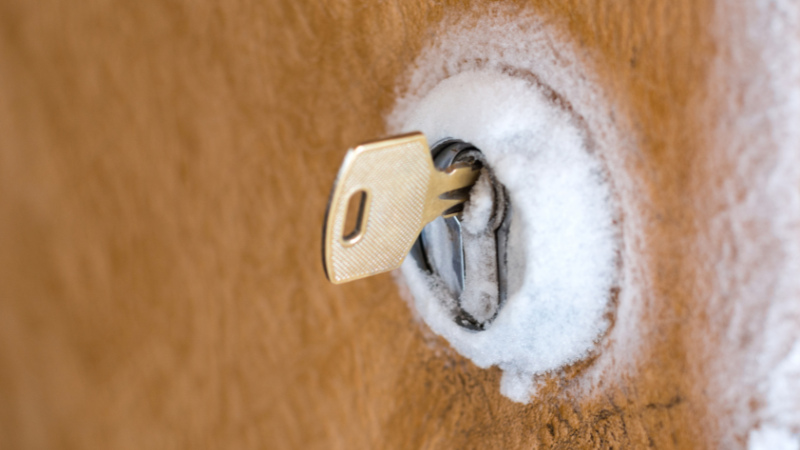It’s getting to the time of year when mechanical things begin to start seizing up. Whether it’s the engine in your car or the hinges on your window, frost is bad news for complex contraptions. Water gets between the intricate moving parts, expands as it freezes overnight, and gradually wears things down. In some cases, the ice will prevent the mechanism from moving at all – a thing you might have encountered when you come to unlock the front door (or your car door) in the morning, only to find that your key won’t turn.
In this article, we’ll take a look at how to thaw frozen door locks. But before we do, let’s think about the tools we’ll need to get the job done. You might already have a few of them available!
Tools Needed
There are several different ways to get a frozen lock moving. You only need one of them to work for the door to be functional again. They are:
- Alcohol-based Hand Sanitiser
- A heat source, be it a cigarette lighter, pocket warmer, or hair-dryer
- WD-40
Now that we’ve got the right tools, let’s take a look at applying them to the problem, and let’s see how to get a frozen door unlocked!
How To Get a Frozen Door Open: Step By Step
Given that hand sanitiser is such a mess-free way of getting the ice melted, it should probably be the first thing you attempt. You need to make sure that the hand-sanitiser you’re using is alcohol based. Not only does the alcohol kill 99% of the germs on your hands, it’ll also break down ice (which is partly why you can stick a bottle of vodka in the freezer without it solidifying). As a side benefit, a bottle of hand-sanitiser will protect you from at least a portion of the germs that are so prevalent during winter – so stock up!
Squeeze a generous dollop of it onto the lock, and then smear it across the key. Work the latter into the former, and you’ll distribute the alcohol throughout the mechanism. The same principle applies to the de-icer you have in your car, though it might be a little more difficult to spray into the inner working of the lock.
Naturally, heat is a fantastic way to melt ice. You can use a cigarette lighter or a pocket-warmer to do the job – just dangle it in front of the lock and wait for the mechanism to conduct the heat. If it’s wear-and-tear rather than ice that’s causing the problem, fire probably won’t be the solution.
Of course, WD40 is flammable, and so too is alcohol. You don’t want to try anything with fire once you’ve applied it. You’ll end up ruining the lock, and possibly causing irreparable damage to the front of the door in the process. Scorch-marks aren’t a good look, so only consider WD-40 if you’ve explored the other options.
If you’re trying to open the door from the inside, or it’s your car door that’s broken, then you might try a hair-dryer. The heating element will blast a stream of warm air into the lock which will, over the course of several minutes, melt the ice. The results aren’t quite as instantaneous as they are when you use a naked flame, but the process is a lot safer.
If you don’t have a source of heat handy, but you do have a can of everyone’s favourite machine lubricant, then you can use it to try to get the lock moving again. Although WD-40 lacks the ice-melting powers of an alcohol-based sanitiser or a de-icer, it will help to protect your lock and ensure that it’s able to move as freely as possible.
Where WD-40 does come into its own is as a preventative measure – apply it occasionally to ensure that everything is able to move freely, and you’ll make problems like this a great deal less likely in the future. We’ll get back to this shortly.
What if I’m stuck outside?

So suppose you find yourself in the nightmare scenario – you’re trapped outside on a cold winter’s night and the key won’t even get into the lock, never mind turn. Don’t panic. The chances are that you just need to apply a little bit of gentle force. Work the key slowly in and out of the lock, and try to wiggle it back and forth as much as possible. Once that little bit of ice has been shifted, you’ll probably find that the lock snaps open.
You can complement the mechanical force you’re applying with a little bit of heat. If you don’t have a lighter handy, then your body’s heat will be sufficient. Warm the key in your hands until it’s above room temperature.
If the door really is a lost cause, then you might try the back door – if you have the keys handy. If you don’t, it might be time to bite the bullet and call for help from a neighbour with a kettle or a hair-dryer handy. We’ll close by saying that frozen doors aren’t a job for a locksmith – if you call one, you’ll be left with an expensive bill, and all they’ll do in return is run through a few of the steps we’ve outlined above.
How can I prevent the door from freezing?
Once you’ve got the door moving, it’s time to think about how to keep it moving. As we’ve mentioned, we can use WD-40 to do this. But a better solution is probably a graphite-based lubricant (or even the graphite from a pencil). The graphite fragments conduct heat very easily, and yet they’re soft enough not to damage the lock. This makes it difficult for little pockets of ice to form. If graphite is distributed throughout the lock, the temperature will need to be markedly lower for the entire thing to seize up. Bear in mind that the graphite in a pencil is less pure than the stuff you get in a bottle (and you might not have a spare pencil lying around). As such, it’s worth investing in a small bottle of the stuff to keep your doors ice-free.





